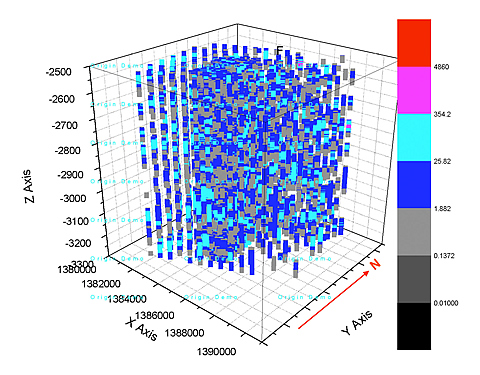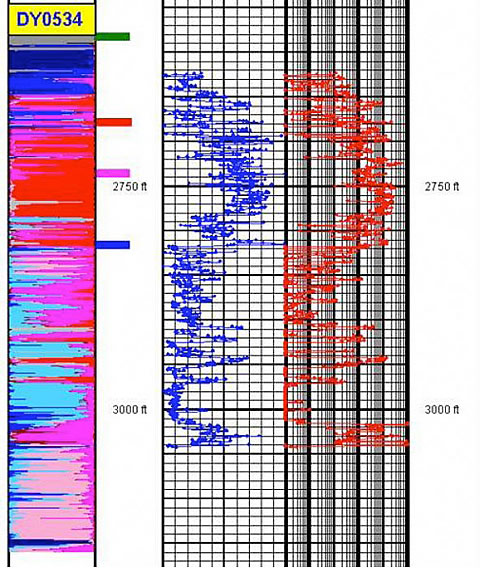Effective oil field management requires 3-D high resolution reservoir characterization to identify reservoir heterogeneity for enhanced recovery efforts, monitoring and CO2 sequestration. Surface seismic is the most cost-efficient method to obtain inter-well volumetric reservoir information to base decisions on, but the vertical resolution is insufficient (>50 ft) for optimal water or CO2 injection management.
The need for high-resolution 3-D data for flow modeling and forecasting performance is increasingly important as the cost of drilling increases. Operators need to know precisely where to drill new and infill wells and where to complete wellbores to penetrate the desired oil producing intervals. ChevronTexaco provided a wide sweep of different data acquired over McElroy field in recent years for the research project and will verify the results of the study by comparing simulation predictions with production data.
Project Results
The project used existing data from McElroy field in west Texas to test data acquisition capabilities to improve vertical resolution and reduce uncertainty in reservoir characterization. The project evaluated a number of methods of data acquisition and cross checked their performance, ranking high-resolution and cost-effective technologies for use by independent operators. Advanced pattern recognition technologies based on artificial neural networks and clustering techniques provide the best, fast, low-cost analysis.
Benefits
Reduced time and lower cost technologies result in "better, faster, cheaper" reservoir characterization and prediction methods for independents. Clustering modeling techniques based on seismic and log derived predictions of porosity and permeability are accurate at a resolution of 10 to 35 ft, and are significantly lower in cost than coring and traditional core interpretations which are very labor intensive.
Project Summary
Seismic techniques developed in recent years leave a "resolution gap" between the surface seismic data with resolution of fifty to hundreds of feet, and sonic and ultrasonic logs with resolution in inches. The detail provided by sonic and ultrasonic logs is too costly for many operators or inapplicable under certain field circumstances. Borehole seismic techniques, including cross well, VSP and reverse VSP offer the best intermediate resolution data to fill the resolution gap.
Advanced pattern recognition technologies relying on artificial neural networks and clustering were used to integrate multi-scale data from cores, logs, seismic, crosswell and VSP data. The idea was to generate high-frequency reservoir descriptions at each 3-D seismic trace location. The objective is to demonstrate and validate the integrated virtual intelligence procedure at a single field.
Pattern Recognition differs from inversion technology
- Data driven modeling, not analytic
- Handles noisy data
- Directly predicts permeability in addition to porosity (not a dependent relationship)
- Deterministic outcome (not a series of equi-probable outcomes)
- Simple and fast
Main data processing elements
- Rock physics modeling
- Identify and prioritize seismic attributes most likely to be influenced by reservoir properties of interest.
- Select attributes for predictive models
- Seismic processing and attribute extraction
- Determine time/depth conversion (integrate seismic data from three successive surveys)
- Collocate surface and crosswell traces (high signal to nose ration in crosswell data causes interpretation problems)
- Velocity analysis using "stacking" velocities was fund to be very reliable for time-depth conversion at McElroy field.
- Log clustering
- Technique results in "smoothing" the log trace
- Logs from 6 wells at McElroy field were used
- The model was validated on 5 wells using 11 variables
- Variables included:
- Porosity and permeability measurements
- Acoustic impedence logs
- 4 cross well attributers
- 4 surface seismic attributes
- Log-Core Model
Acoustic impedence was determined to be a good predictor of porosity using the clustering analysis technique. An inverse trend between well log acoustic impedence and porosity exists because porosity increase as bulk density decreased and as velocity decreases. Permeability can be related to porosity for predictive purposes.
Conclusions
- The Cluster model using acoustic impedence provided reasonable predictions of porosity and permeability using surface seismic attributes.
- Crosswell data did not improve he results, but this may be due to poor quality of crosswell data from McElroy field.
- Improvement in vertical resolution for porosity and permeability predictions was achieved over the traditional surface seismic frequency methods.
- Better quality crosswell data might further improve the predictive capability of the model.
- The time/depth transform can be improved by use "depth windowing" techniques.
- Cluster models yields good trends of reservoir properties on a vertical resolution of 10 to 35 ft. This is a modest improvement over surface seismic frequency (>50ft).
- The cluster model techniques were applied at McElroy field (a carbonate reservoir) because of availability of data. Application in clastic facies will allow for improved data acquisition and results.





